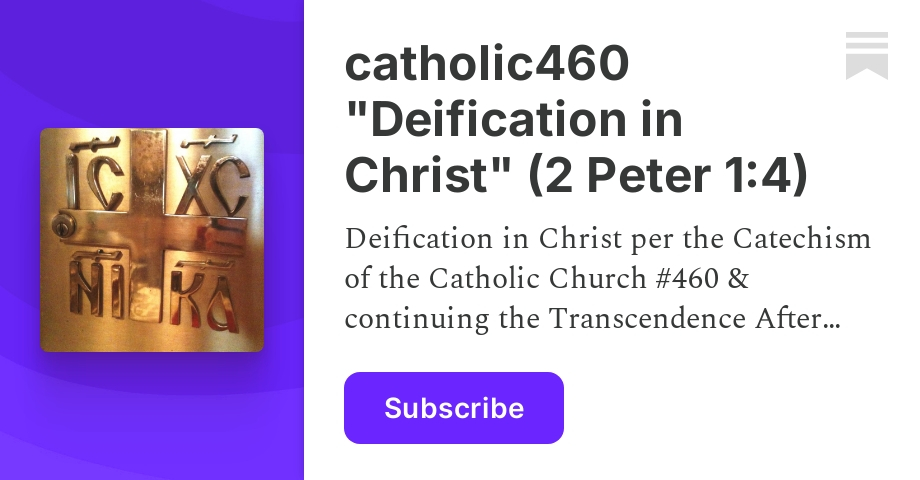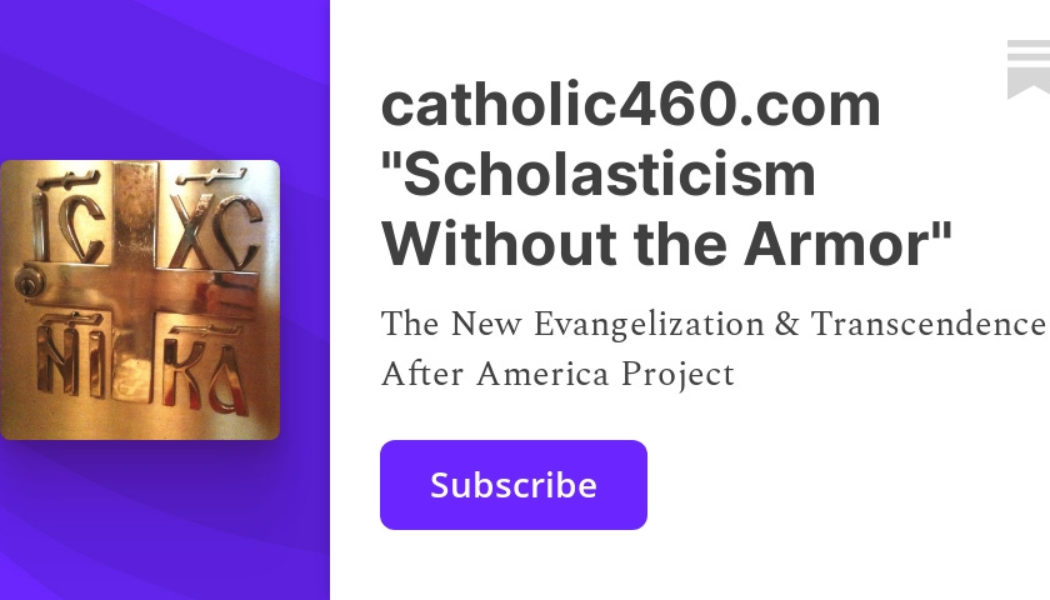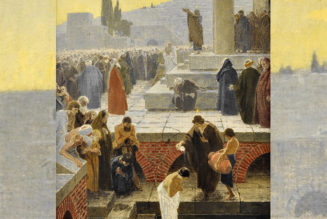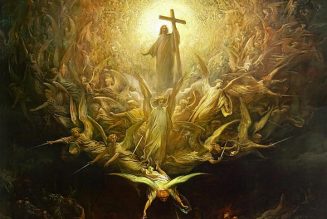
“Incorporated into the Church by Baptism, the faithful have received the sacramental character that consecrates them for Christian religious worship. The baptismal seal enables and commits Christians to serve God by a vital participation in the holy liturgy of the Church and to exercise their baptismal priesthood by the witness of holy lives and practical charity.” CCC #1273 [bold mine]
[you might want a Bible to accompany this essay as the biblical references are important]
New Priesthood and Embodied Spiritual Sacrifices
Through Jesus’ sacrifice and institution of his Body and Blood, participation into the true and heavenly sanctuary was re-established for all who believe on and in Jesus Christ (cf. Heb 10:19-22). With the liturgical renovation that Jesus began in the Upper Room (“do this in commemoration of me”) and completed on the Cross, something greater than what the Levites possessed was established. Jesus established a new priesthood that granted Christians daily entrance into God’s true dwelling; something much greater than the Tent of Meeting in which the Levites served (cf. Heb 6:20, 9:24, 10:1).
In making available entrance into the true Tent, Jesus mandated that his disciples must exceed “the righteousness of the scribes and Pharisees or you will never enter the kingdom of heaven” (cf. Mt 5:20). With the new priesthood for Christians came laws that touch upon our entrance into the new and true sanctuary while we are still in the flesh: “For when there is a change in the priesthood, there is necessarily a change in the law as well” (Heb 7:12). These laws involved loving in the truth and in sincerity; authentic chastity for which Old Testament holiness laws were mostly symbolic.
Even though entrance into the new sanctuary – Jesus’ risen Body and Blood at the right hand of the Father (cf. Rev 3:21) – is mystical and through new veils of the appearance of bread and wine (cf. Heb 10:19-22; John 6:53-58; Mt 26:26-28), the mystical is not opposed to the bodily. Rather, the mystical presupposes the bodily. Our bodies make possible the habitual sacrifice of our embodied wills to the will of the Lord. Our embodied human wills enable us to be received into heavenly powers (cf. Heb 6:5) and renewed: “like living stones be yourselves built into a spiritual house, to be a holy priesthood, to offer spiritual sacrifices to God through Jesus Christ” (1 Peter 2:5); “present your bodies as a living sacrifice, holy and acceptable to God, which is your spiritual worship” (Rom 12:1).
Spiritual sacrifices are not opposed to the body; and the body is made for participation in the Spirit. Spiritual sacrifices are offered through the body in the human will’s bodily surrender to God’s will as Jesus did. What we do with our bodies and chastity matters because bodies are extensions of our human wills and they reveal our commitments to loving in truth. Without the surrender of our embodied human wills to God’s will – that we live lives of goodness and truthfulness – there is no entrance into the Holy of Holies (“participation in the divine nature” 2 Peter 1:4) which faith in Christ makes possible.
Jesus has accomplished the total surrender of his human will through his body to the will of his Father (cf. Hebrews 10:5, 9-10), an integral and total gift of self: “And by that will we have been sanctified through the offering of the body of Jesus Christ once for all.” God and humanity are now forever joined in Christ’s bodily resurrection as Jesus became the source of our new holiness and sharing in the Spirit of sonship. Now as our high priest in heaven, Jesus helps us accomplish the same offering of our lives to God through him, with him and in him by the Spirit he pours out upon us in Holy Communion (cf. Hebrews 10:19; 1 Cor 15:45).
Since Holy Communion is mystical entrance into heavenly realities by the Spirit, through the risen body of Christ (cf. 1 Cor 15:45), not only was a cleansing of the body necessary for the new priesthood of Jesus, but a cleansing of the heart by the Spirit: “…I will cleanse you. A new heart I will give you and a new spirit I will put within you…I will put my spirit within you, and cause you to walk in my statutes” (Ezek 36:25b-27; cf. Jer 31:31-33). The Spirit give us authentic love: chaste love that does not seek to use others but develop others. Through Jesus, his disciples are empowered to love as God loves us and so be taken by the Spirit to cross into God’s true sanctuary and eternal life through Jesus’ Body and Blood. The body not being opposed to Spirit, just like in Jesus’ resurrection, we come to show God’s love through our bodily choices, commitments, and charity towards our neighbors in the same Spirit.
No Divorce [for remarriage]: The New Law of Entering God by the Commitment to Love as God Loves
In preparation for what Jesus would accomplish through his Sacrifice, Jesus told his future disciples, and those who would receive the new priesthood of Sonship by baptism, “…Unless your righteousness exceeds that of the scribes and Pharisees, you will never enter the kingdom of heaven” (Mt 5:20). The perfection of love in the New Covenant would flow from internal righteousness caused by the Spirit producing faith in Christ; and, the love of Christ impelling us into external witness, righteousness, and action. This is the embodied spiritual worship in the kingdom to which Peter and Paul witnessed.
This righteousness to “exceed the scribes and Pharisees” was not from man’s power, but from faith in Christ which the Spirit would accomplish in all who believe in Jesus. Invitation to this righteousness and participation in the kingdom was immediately followed by Jesus’ teaching against divorce. To abide in Jesus and be refreshed through Communion with him, the priesthood of the baptized in Christ would have to abide in Christ’s love and faithfulness (cf. Ephesians 5:28-32) by committing to loving others even when others cease to love them: “For if you love those who love you, what reward have you?…You therefore must be perfect as your heavenly Father is perfect” (Mt 5:44-48). This is the context for the new priesthood, new laws for the new priesthood (cf. Heb 7:12), and teachings against divorce and remarriage for those who wish to participate in Jesus’ Body and Blood; where two become one flesh (cf. Eph 5:31-32).
“It was also, said, ‘Whoever divorces his wife, let him give her a certificate of divorce.’ But I say to you that everyone who divorces his wife, except on the ground of unchastity [porneias in Greek] makes her an adulteress; and whoever marries a divorced woman commits adultery” (Mt 5:31-32). The term porneias is simply a reference to illegal marriages that were never valid.[1] It has nothing to do with the sad and sorrowful situation of a spouse cheating on the other after a valid marriage has occurred. As seen in Luke 16:18, the point is clear: there is no longer divorce and remarriage for disciples of Christ. Separation is permitted for those validly married, but not remarriage, because unlike the Old Testament laity, Jesus’ disciples were about to start participating in the actual Holy of Holies, the kingdom of God (participation in the Divine Will through the indwelling Spirit of God), especially in Holy Communion. Remarriage would be a form of adultery against one’s spouse; and, living in adultery would be contrary to the faithful love expressed by participation in Holy Communion where we seek to be renewed by the faithful love given by Jesus.
Opening the Heavenly Jerusalem to the Priesthood of the Baptized
Soon after reaffirming the Sermon’s teaching against divorce in Matthew 19, Jesus overthrew the moneychangers’ tables (Matthew 21) in view of implementing his Body and Blood at the Last Supper (cf. Rabbi Neusner).[2] Old Testament sacrifice was to be replaced with New Covenant sacrifice. Jesus was foreshadowing his replacement of the Levitical priesthood and Temple with his glorified body and Holy Communion. There was always an inseparable connection between Jesus’ institution of his Body and Blood and teachings against divorce and remarriage: both are about abiding in the kind of covenantal love necessary to entering or abiding in holy communions:[3] “This is a great mystery [sacramentum], and I mean in reference to Christ and the Church” (Ephesians 5:32).
When Protestants broke with the understanding that the apostolic succession (or ministerial priesthood) was instituted to unite heaven and earth sacramentally and mystically – “what you bind on earth is bound in heaven” (Mt 16:19; 18:18) – for participation in “the powers of the age to come” (Heb 6:5), they lost sight that the Eucharist is the wedding feast of the Lamb (cf. Rev 19:9; Rev 21:14,22). Holy Communion is momentary entrance into the Heavenly Jerusalem even before one’s final passing into eternity. The Heavenly Jerusalem is about God’s faithful love and living within it; our human wills infused with God’s faithful love and making our wills like God’s will. This is why “those who have not defiled themselves with women, for they are chaste [parthenoi]” (Rev 14:4 RSV) are allowed to enter and go in and out of the city gates of the Heavenly Jerusalem (cf. Rev 22:14) in Holy Communion (cf. John 14:3).
In context, the Greek word parthenoi in Revelation 14:4 [RSV] is translated “chaste” instead of “virgins.”[4] Parthenoi captures the meaning in contrast to the “unchaste” who participate in porneia [unchastity] and those excluded from participation in the Lamb per the similar Greek term pornois or “fornicators” of Revelation 21:8. The very term pornois of Revelation 21:8 takes us right back into what Jesus was teaching about marriage in the Sermon on the Mount (and repeated in Matthew 19) when he said no divorce “except for porneias.” Jesus was requiring the love of his disciples to be sincere and truthful [chaste], to live the faithfulness pledged to their spouses that he lives in his faithfulness to the members of his Church when he “espoused” them in Baptism (2 Cor 11:2; Hosea 2:19; Eph 5:31-32). In Baptism, Jesus made us priests of his God and Father (cf. Rev 1:6, 5:10, 20:6); he made us sons and made us holy.
“Divorce” is only allowable if in fact the marriage was “unlawful” in the first place, and thus always invalid. Unlawful marriages, like incest (porneia in 1 Cor 5:1), or taking one’s brother’s wife (cf. Mt 14:4; Lev 20:21) was really a form of immorality or unchastity (porneia) and not marriage. In no way was Jesus making a justification for actual divorce. Rather he was emphasizing that we must leave behind all porneia (unchastity) in order to commune with Jesus in holiness and honesty; in the “unleavened bread of sincerity and truth” (1 Cor 5:8; cf. 1 Cor 11:27). Thus, any abiding in porneia (sexual immorality) – which is just using others to satisfy lust (and so intrinsically self-centered) – must be abandoned and confessed before trying to enter Holy Communion with Christ (cf. Rev 21:8; 1 Cor 11:27-29).
Accepting Divorce and Remarriage, Catholics are Working Against Jesus’ Law
Historically, the Protestant Reformation ended in a revolt and dissolution of Christ’s institution at the Last Supper. Throwing out the baby with the bathwater, Protestants separated themselves from authentic apostolic understandings of John’s Book of the Apocalypse and the mystery of the Eucharist as the mystery of the Lamb of God made accessible to Christians. Protestants lost the understanding of the Eucharist as entrance into the Holy of Holies by the new priesthood (cf. Hebrews 7:11-12) and mystical sanctuary (cf. Heb 10:19, 12:22; Rev 14:1-5, 21:14,22) established by the Son of God. It happened because they lost the apostolic succession’s authority to “bind and loose” (Mt 16:19; 18:18) and so join heaven and earth. No authority to “bind and loose” meant no transubstantiation. No transubstantiation meant no joining of heaven and earth really, truly, and substantially. For Protestants, Jesus’ institutions necessarily became mere externals and symbols without true mystery; contradicting what Jesus intended and accomplished.
Contrary to Ephesians 5:32 and all apostolic liturgical tradition, no nuptial mystery (cf. Hosea 2:19-20; Ezek 16:8, 62-63) was made present for Protestants in their understanding of Jesus’ institution of his Body and Blood at the Last Supper. It was all just symbols and externals that signified friendship but caused no further transformation into sonship by his mysteries. For Protestants, no new temple system was coming into existence based upon Jesus’ institutions and resurrected and glorified body, so the connection between reception of Holy Communion and Jesus’ forbiddance of divorce lost its meaning. With Protestant loss of apostolic succession and the Eucharist, a new form of neo-Judaism (re-acceptance of divorce as with Moses’ accommodation) was reintroduced amongst Christians in total contradiction to Jesus’ teachings in the Sermon on the Mount and Matthew 19. Afterall, for neo-Judaizing Christians, if divorce was O.K. for hardened hearts of Moses’ time, isn’t it good enough for hardened hearts of modern times?
Of course not! That’s the definition of apostasy from the New Covenant in Jesus’ blood. Divorce was good enough for Moses’ time because none of those men or laity were permitted to enter the Tent of Meeting and the Holy of Holies (which became the Temple). More importantly, we must not forget that there were unique laws concerning marriage as regards Levitical priests. While laity were allowed divorce in the Old Testament (those laity who were already forbidden from the Tent), divorce was condemned and forbidden to the priests who served in the Tent. Divorce was forbidden to the Levitical priests (cf. Lev 21:13-15 & Malachi 2:14-16) and the high priest could only enter the Holy of Holies once a year.
If God chastised the Levites for throwing away their wives and said, “I hate divorce,” (Mal 2:16) and, “…nor shall [the priest] marry a woman divorced from her husband” (Lev 21:7), then much more so would divorce and remarriage be forbidden the new priesthood of the baptized in Christ. They have a higher priesthood of sonship and can enter daily the Holy of Holies in the Temple of Jesus’ risen Body and Blood. Through Jesus, his baptized are more holy than the Levitical high priesthood which was instituted under Moses. Now Jesus’ teaching makes more sense: “Moses said to you…but I [who open the Holy of Holies] say to you…”
Concerning divorce, and lack of faith in Christ’s real, true and substantial presence in Holy Communion, Catholics are now as Protestant as the “Reformers.” Less than 30% of professed Catholics currently accept the Church’s teachings on transubstantiation. Having lost an understanding of Jesus as the new mystical Temple (“a life-giving Spirit” 1 Cor 15:45) entered in Holy Communion, Catholics trample the Holy of Holies without amending our lives with Penance before reception; heaping sin upon sin upon ourselves: “Whoever, therefore, eats the bread or drinks the cup of the Lord in an unworthy manner will be guilty of profaning the body and blood of the Lord” (1 Cor 11:27). Living in adultery or other forms of porneia forbids Holy Communion because it is contrary to the love expressed in Holy Communion.
Faced with rampant divorce now afflicting Catholics as much as Protestants, and the issue of divorce and remarriage being treated too superficially by the leaders of everyone involved, it is feared by many balanced and orthodox Christians that a great apostasy has begun to set-in. Simply allowing the divorced and remarried to enter the Holy of Holies without a true ruling[5] that their prior attempted marriages were porneia, would be heretical because it would sanction adultery. To lie about the status of valid marriages in order to foster annulments would be even worse. It would absolutely contradict what Jesus the Son of God instituted and taught. Perhaps a rediscovery of Scripture in the Tradition and the “baptismal priesthood” will go a long way in remedying the situation.
In the meantime, the message of Malachi is now properly applied to many in the apostolic succession (ministerial priesthood). They are the successors of Levi (cf. Psalm 110), who guard the way to the Tree of Life (God’s True Presence in the Eucharist cf. Rev 2:7), in their authority to “bind and loose” and make Holy Communion available to the priesthood of the baptized:
“But you have turned aside from the way; you have caused many to stumble by your instruction; you have corrupted the covenant of Levi, says the LORD of hosts, and so I make you despised and abased before all the people, inasmuch as you have not kept my ways but have shown partiality in your instruction.” Malachi 2:8-9
[1] See the study by: Paul Mankowski, “The Dominical Teaching on Divorce and Remarriage: The Biblical Data,” in Remaining in the Truth of Christ: Marriage and Communion in the Catholic Church, ed. Robert Dodaro (San Francisco: Ignatius Press, 2014), pp. 36-63, at 62. Cheating before and during the exchange of vows raises the possibility of invalidity on the grounds of porneias and lying.
[2] cf. Jacob Neusner in Thomas Lane, “The Jewish Temple is Transfigured in Christ and the Temple Liturgies are Transfigured in the Sacraments,” in Antiphon: A Journal for Liturgical Renewal, Volume 19, Number 1, 2015, pp. 14-28 at 21 [digital at Project Muse].
[3] Matthew Tsakanikas, “Understanding Marriage Through Holy Communion,” in Logos: A Journal of Catholic Thought and Culture, Volume 7, Number 2, Spring 2004, pp. 118-136
[4] See also the RSV footnote on the verse.
[5] I leave aside how Pauline and Petrine Privileges are based on the baptized becoming a new creation. Other essays and authors deal with these questions.
[Editor’s note: For Catholics, a “lawful” Christian marriage is one that meets minimal requirements of Church law [primarily] and civil law where the marriage takes place [age requirements, witnesses, etc…] and as a basis for validity. Minimum requirements to exchange marriage vows presuppose at the time of the attempted marriage: internal freedom [sanity and maturity, etc…] and external freedom [not threatened or not currently married, etc…] in order to give consent to marriage; understanding and commitment to marriage’s permanence [no divorce for remarriage]; the intention and commitment to fidelity and capacity for it [serious sexual or drug addictions aren’t in the way, etc…]; ability to consummate a marriage; and, openness to having children [and minimal mental fitness and capacity to provide for children]. Validity is presumed when a Church pastor permits the marriage to take place in accord with norms of the diocese. A Catholic is not free to marry without permission of the parish pastor overseeing the marriage preparation of the couple.]








![My Struggle Session at Stanford Law School [WSJ Paywall]…](https://salvationprosperity.net/wp-content/uploads/2023/03/my-struggle-session-at-stanford-law-school-wsj-paywall-327x219.jpg)
